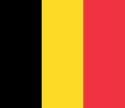Ruanda-Urundi facts for kids
Quick facts for kids
Ruanda-Urundi
|
|||||||||||
|---|---|---|---|---|---|---|---|---|---|---|---|
| 1922–1962 | |||||||||||
|
|
|||||||||||
| Status | Mandate of Belgium | ||||||||||
| Capital | Usumbura | ||||||||||
| Common languages | French, Dutch | ||||||||||
| Religion | Roman Catholicism | ||||||||||
| History | |||||||||||
|
• Established
|
November 1 1922 | ||||||||||
|
• Independence
|
July 1 1962 | ||||||||||
| Currency | Belgian Congo franc | ||||||||||
|
|||||||||||
Ruanda-Urundi was a territory in Central Africa. Today, this area is made up of the independent countries of Rwanda and Burundi. For many years, Ruanda-Urundi was controlled by European powers.
First, it was part of German East Africa starting in the late 1800s. Then, during World War I, Belgium took control of the area in 1916. After the war, in 1922, the League of Nations officially gave Belgium the job of governing Ruanda-Urundi. This was called a "mandate." Belgium continued to rule until 1962, when both Rwanda and Burundi became independent nations.
Contents
How Ruanda-Urundi Was Governed
After World War I, the League of Nations was created to help keep peace and manage territories that were no longer under their previous rulers. Ruanda-Urundi became a "mandate" territory, meaning Belgium was given permission to govern it, but they were supposed to help the people there prepare for self-rule.
Belgian Rule and Administration
Belgium governed Ruanda-Urundi through a system of "Royal administrators." These were officials sent from Belgium to manage the territory. They were in charge of everything from law and order to developing the economy.
Royal Commissioners (1916-1926)
The first leaders were called Royal Commissioners. They were military officers or high-ranking officials who oversaw the territory right after Belgium took control.
- Justin Malfeyt (November 1916 - May 1919)
- Alfred Frédéric Gérard Marzorati (May 1919 - August 1926)
Governors (1926-1962)
Later, the leaders were called Governors. They were also known as Deputy Governors-General of the Belgian Congo, showing how closely Ruanda-Urundi was linked to Belgium's larger colony in Africa. These governors were responsible for the daily running of the territory until it gained independence.
- Alfred Frédéric Gérard Marzorati (August 1926 - February 1929)
- Louis Joseph Postiaux (February 1929 - July 1930)
- Charles Henri Joseph Voisin (July 1930 - August 1932)
- Eugène Jacques Pierre Louis Jungers (August 1932 - July 1946)
- Maurice Simon (July 1946 - August 1949)
- Léon Antoine Marie Pétillon (August 1949 - January 1952)
- Alfred Claeys Boùùaert (January 1952 - March 1955)
- Jean-Paul Harroy (March 1955 - January 1962)
Transition to Independence
After World War II, the League of Nations was replaced by the United Nations. Ruanda-Urundi then became a "United Nations trust territory." This meant the UN supervised Belgium's rule, pushing for the territory to become independent. Finally, on July 1, 1962, Ruanda-Urundi split into two separate, independent countries: Rwanda and Burundi.
Images for kids
-
A Belgian Congo stamp overprinted for the Belgian Occupied East African Territories in 1916
-
Ruandan labour migrants at the Kisanga copper mine in Katanga (Belgian Congo) in c. 1930
-
Monument in Bujumbura commemorating Burundi's independence on 1 July 1962
See also
 In Spanish: Ruanda-Urundi para niños
In Spanish: Ruanda-Urundi para niños









